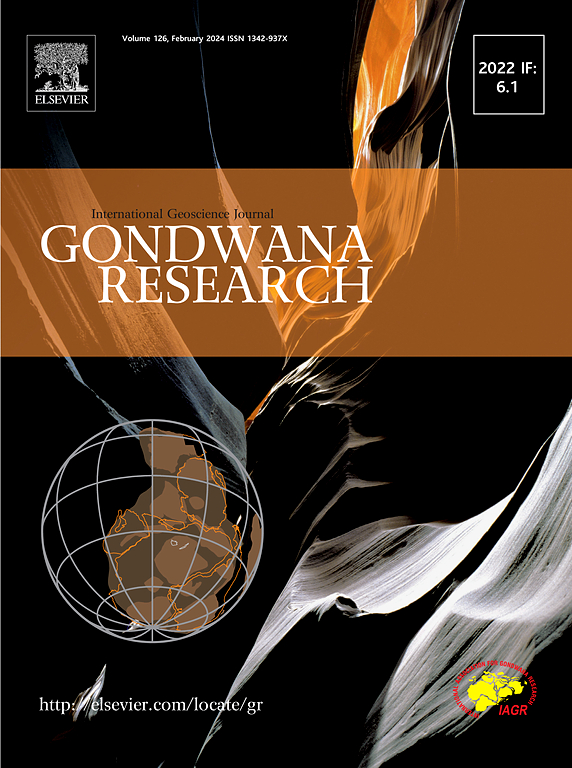Tectonic attribute of the Lincang terrane in the eastern Tethyan domain
IF 7.2
1区 地球科学
Q1 GEOSCIENCES, MULTIDISCIPLINARY
引用次数: 0
Abstract
Closure of the Proto–Tethys Ocean and opening of the Paleo–Tethys Ocean played crucial role in the global plate tectonic reconfiguration in the early to late Paleozoic transition. How the Proto– and Paleo–Tethys transition occurred in the eastern Tethyan domain has been a topic of hot debates in the last decades. Compilation of published and our new data on detrital zircon U–Pb dating and whole–rock geochemical analysis from the Lincang and contiguous blocks in the eastern Tibetan Plateau provide constraints on the paleogeographic positions and tectonic affinities of these blocks during the Proto– to Paleo–Tethys Ocean evolution in the Paleozoic. The results show that the Lincang terrane, as a magmatic arc terrane, was geographically proximal to the Baoshan block in the northern margin of the Australian and Indian plates of the Gondwana during the early Paleozoic. The block, however, drifted as part of the passive margin of the South China–Indochina block in the Paleo–Tethys Ocean and received sedimentary inputs from the latter. Through MDS analysis of detrital zircon data, the Yunxian-Menghai Proto–Tethys ocean to Changning-Menglian Paleo–Tethys ocean, in which the Baoshan and Lincang blocks were evolved. The Changning-Menglian Paleo-Tethys Ocean opened as a post-collisional rift basin. Closure of the Proto–Tethys Ocean was followed by opening of the Paleo–Tethys Ocean that separated the Lincang terrane from the Greater Gondwana. This study reveals that changes in mantle convection regime during the plate interactions and evolution of ocean basins are the primary driving forces behind the subduction of oceanic plates, and rifting and drifting of continental blocks. The study underscores the intricate dynamics of plate tectonics and the significance of geochronological and geochemical investigations in deciphering the complex history of continental blocks and plate interactions.

特提斯东域临沧地体构造属性
原特提斯洋的闭合和古特提斯洋的打开在早-晚古生代过渡时期全球板块构造重构中起着至关重要的作用。在过去的几十年里,原始和古特提斯是如何在特提斯东部地区发生转变的一直是一个热门的话题。本文整理了青藏高原东部临沧及邻近地块已发表的碎屑锆石U-Pb定年和全岩地球化学分析资料,为这些地块在古生代原-古特提斯海洋演化过程中的古地理位置和构造亲缘关系提供了约束条件。结果表明,临沧地体在早古生代地理位置上与冈瓦纳澳、印板块北缘宝山地块接近,为岩浆弧地体。然而,该地块在古特提斯洋中作为华南-印度支那地块被动边缘的一部分漂移,并接受后者的沉积输入。通过对碎屑锆石资料的MDS分析,认为云县-勐海原特提斯洋至长宁-孟连古特提斯洋,其中发育宝山和临沧地块。长宁-孟连古特提斯洋为碰撞后裂谷盆地。原特提斯洋关闭之后,古特提斯洋打开,将临沧地与大冈瓦纳分开。研究表明,板块相互作用和洋盆演化过程中地幔对流格局的变化是洋板块俯冲和大陆块体裂陷漂移的主要驱动力。该研究强调了板块构造的复杂动力学,以及地质年代学和地球化学研究在破译大陆块体和板块相互作用的复杂历史中的重要意义。
本文章由计算机程序翻译,如有差异,请以英文原文为准。
求助全文
约1分钟内获得全文
求助全文
来源期刊

Gondwana Research
地学-地球科学综合
CiteScore
12.90
自引率
6.60%
发文量
298
审稿时长
65 days
期刊介绍:
Gondwana Research (GR) is an International Journal aimed to promote high quality research publications on all topics related to solid Earth, particularly with reference to the origin and evolution of continents, continental assemblies and their resources. GR is an "all earth science" journal with no restrictions on geological time, terrane or theme and covers a wide spectrum of topics in geosciences such as geology, geomorphology, palaeontology, structure, petrology, geochemistry, stable isotopes, geochronology, economic geology, exploration geology, engineering geology, geophysics, and environmental geology among other themes, and provides an appropriate forum to integrate studies from different disciplines and different terrains. In addition to regular articles and thematic issues, the journal invites high profile state-of-the-art reviews on thrust area topics for its column, ''GR FOCUS''. Focus articles include short biographies and photographs of the authors. Short articles (within ten printed pages) for rapid publication reporting important discoveries or innovative models of global interest will be considered under the category ''GR LETTERS''.
 求助内容:
求助内容: 应助结果提醒方式:
应助结果提醒方式:


